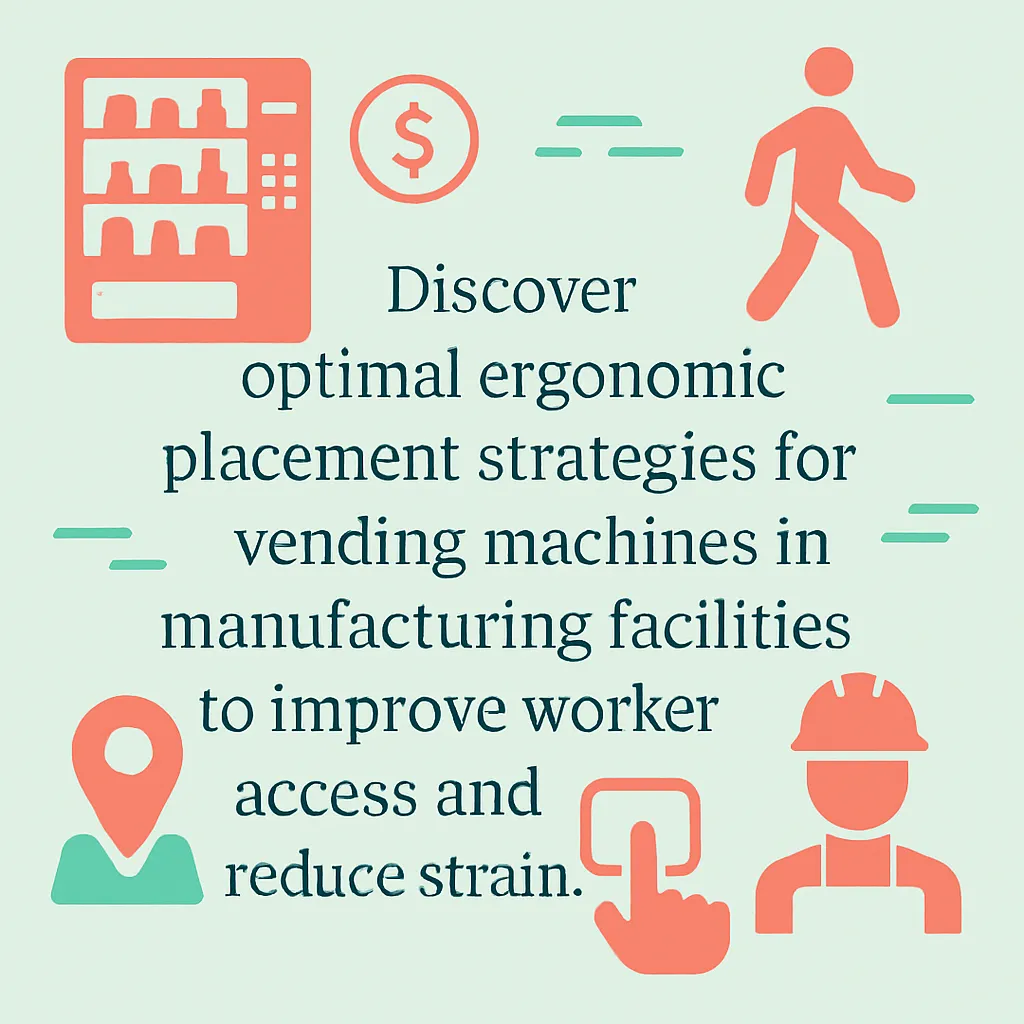Ergonomic Vending Machine Placement in Factories
Discover optimal ergonomic placement strategies for vending machines in manufacturing facilities to improve worker access and reduce strain.
Back to Vending for Manufacturing ResourcesDiscover optimal ergonomic placement strategies for vending machines in manufacturing facilities to improve worker access and reduce strain.
Back to Vending for Manufacturing ResourcesStrategic placement of vending machines in factory environments ensures employees have convenient access to refreshments, minimizing downtime and physical strain associated with long treks to distant break areas.
![]() Reduces walking distance and fatigue for factory workers
Reduces walking distance and fatigue for factory workers
![]() Enhances accessibility for all employees, improving inclusivity
Enhances accessibility for all employees, improving inclusivity
![]() Boosts productivity by minimizing break disruptions
Boosts productivity by minimizing break disruptions

In demanding manufacturing environments, every detail impacts worker efficiency and safety. Ergonomic vending machine placement is a critical consideration often overlooked, yet it can significantly contribute to a more productive and comfortable workforce. By strategically positioning refreshment options, factories can reduce worker fatigue, minimize time away from production lines, and foster a healthier work atmosphere. This isn't just about convenience; it's about integrating wellness directly into the workflow, where vending machines for industrial facilities become a key support system.
Ergonomics in a factory setting means designing the workplace to fit the worker. For vending machines, this translates to placing them where they are most needed and easiest to access. Consider high-traffic crossroads, centralized break areas, or even specific production zones where breaks are naturally staggered. The goal is to reduce unnecessary walking, bending, or reaching, allowing employees to quickly grab a revitalizing snack or drink and return to their duties with minimal disruption. This thoughtful approach can dramatically affect daily operations and overall employee satisfaction, making the break experience seamless and efficient.
Long shifts and repetitive tasks are common in manufacturing. Easy access to hydration and energy-boosting snacks helps maintain concentration and physical stamina. When vending machines are placed ergonomically, workers don’t have to spend valuable break time traversing large areas of the factory floor. This quick access supports consistent energy levels and can help prevent the dips in focus that can lead to errors or slower production. Moreover, providing readily available refreshments signals that employee wellbeing is a priority, which can positively impact morale and retention. Prioritizing well-being extends to ensuring healthy vending for factory workers is available.
Ergonomic placement isn't just about proximity; it’s also about accessibility. Machines should be placed on level surfaces, within clear pathways, and at heights that are comfortable for all users, including those with varying physical needs. Clear signage and ample space around the machines ensure that employees can approach, select items, and move away without obstruction or risk. This inclusive approach to vending machine placement directly contributes to a safer, more welcoming environment for everyone in the factory. Additionally, factories may want to explore touchless vending in manufacturing environments for enhanced hygiene.
Ergonomic placement involves strategically locating vending machines in manufacturing facilities to minimize worker effort, reduce injury risk, and optimize access to refreshments, considering workflow.
It enhances worker safety, improves efficiency by reducing long trips to break areas, and boosts morale by providing easily accessible hydration and snacks, directly impacting productivity.
Optimal locations include natural break areas, near water fountains, in centralized lunchrooms, or at key transition points between different production zones, ensuring high visibility and easy reach.
Well-placed machines reduce the time workers spend walking to get refreshments, minimizing disruption to workflow and allowing them to return to tasks faster, thus improving overall productivity.
Consider factory layout, traffic flow, distance from workstations, accessibility for all employees (including those with mobility issues), and proximity to electrical outlets and water sources.
By ensuring machines are at an appropriate height and within easy reach, and by placing them in well-lit, uncluttered areas, the physical strain on workers during their breaks can be significantly reduced.
Combo machines save space, while smaller, more compact units can fit into strategic, tight areas, all while ensuring features like accessible payment interfaces.
Placement should be reviewed periodically, especially after changes in factory layout, workflow, or if employee feedback indicates issues with accessibility or convenience.
Ensuring accessibility for all employees, including those with disabilities, promotes inclusivity, complies with regulations, and boosts overall employee satisfaction and comfort.
Collecting feedback from factory workers provides direct insights into their needs and preferences regarding machine locations, helping to fine-tune placement for maximum benefit.